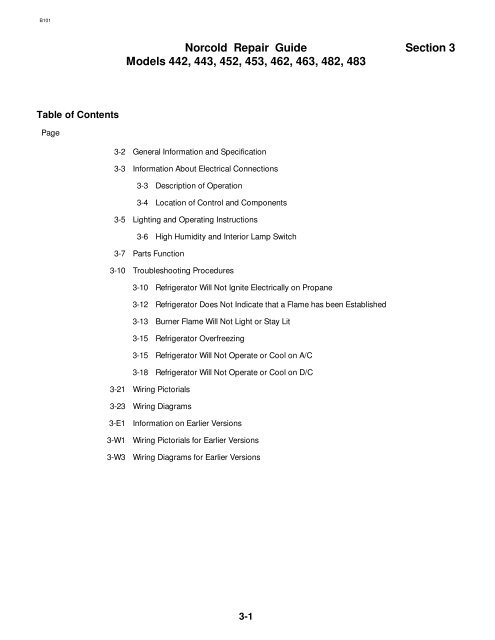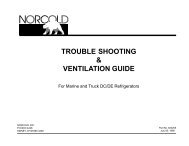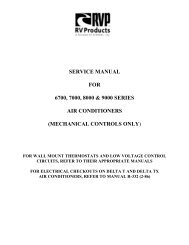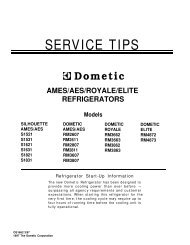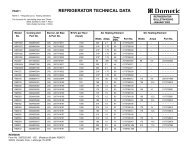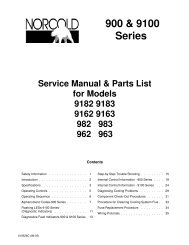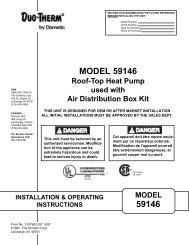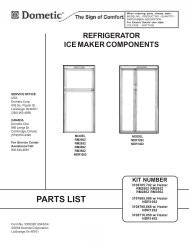Norcold Repair Guide Models 442, 443, 452, 453, 462, 463, 482 ...
Norcold Repair Guide Models 442, 443, 452, 453, 462, 463, 482 ...
Norcold Repair Guide Models 442, 443, 452, 453, 462, 463, 482 ...
You also want an ePaper? Increase the reach of your titles
YUMPU automatically turns print PDFs into web optimized ePapers that Google loves.
B101<strong>Norcold</strong> <strong>Repair</strong> <strong>Guide</strong><strong>Models</strong> <strong>442</strong>, <strong>443</strong>, <strong>452</strong>, <strong>453</strong>, <strong>462</strong>, <strong>463</strong>, <strong>482</strong>, 483Section 3Table of ContentsPage3-2 General Information and Specification3-3 Information About Electrical Connections3-3 Description of Operation3-4 Location of Control and Components3-5 Lighting and Operating Instructions3-6 High Humidity and Interior Lamp Switch3-7 Parts Function3-10 Troubleshooting Procedures3-10 Refrigerator Will Not Ignite Electrically on Propane3-12 Refrigerator Does Not Indicate that a Flame has been Established3-13 Burner Flame Will Not Light or Stay Lit3-15 Refrigerator Overfreezing3-15 Refrigerator Will Not Operate or Cool on A/C3-18 Refrigerator Will Not Operate or Cool on D/C3-21 Wiring Pictorials3-23 Wiring Diagrams3-E1 Information on Earlier Versions3-W1 Wiring Pictorials for Earlier Versions3-W3 Wiring Diagrams for Earlier Versions3-1
B101General Information and SpecificationOPERATING LIMITS - ALLMODELSAC Mode: 132 VAC Max., 108VAC Min.15.4 VDC Max., 10.5VDC Min.DC Mode: 15.4 VDC Max., 11.5VDC Min.Gas Mode: 11" W.C. Gas Supply10.5" W.C. Min. BurnerPressure (High Fire)15.4 VDC Max., 10.5VDC Min.MODELS <strong>442</strong>, <strong>443</strong>RATINGS1050 Btu/Hr InputLP Gas Mode:11" W.C. Gas SupplyLP14 Orifice12 Volts DC control voltageAC Mode:110 Volts AC, 200 WattsDC Mode (3-Way only):12 Volts DCMODELS <strong>452</strong>, <strong>453</strong>RATINGS1200 Btu/Hr InputLP Gas Mode:11" W.C. Gas SupplyLP14 Orifice12 Volts DC control voltageAC Mode:110 Volts AC, 200 WattsDC Mode (3-Way only):12 Volts DC12 Volts DC control voltageAC Mode:110 Volts AC, 300 Watts12 Volts DC control voltageDC Mode (3-Way only):12 Volts DCMODELS <strong>482</strong>, 483RATINGS1500 Btu/Hr InputLP Gas Mode:11" W.C. Gas SupplyLP16 Orifice12 Volts DC control voltageAC Mode:110 Volts AC, 300 Watts12 Volts DC control voltageDC Mode (3-Way only):12 Volts DCCURRENT DRAWS - <strong>442</strong>, <strong>443</strong>, <strong>452</strong>, <strong>453</strong>Relighter - 30 milliampsAC Heating Element - 1.5 amps at 110 Volts AC1.7 amps at 120 Volts ACDC Heating Element - 9.2 amps at 12 Volts DC10.7 amps at 14 Volts DCCURRENT DRAWS - <strong>462</strong>, <strong>463</strong>, <strong>482</strong>, 483Relighter - 30 milliampsHumidity Heater - 240 milliamps or .24 ampsInterior Lamp (when door open) - 600 milliamps or .60 ampsAC Heating Element - 2.7 amps at 110 Volts AC2.9 amps at 120 Volts ACDC Heating Element - 13.8 amps at 12 Volts DC16.1 amps at 14 Volts DCMODELS <strong>462</strong>, <strong>463</strong>RATINGS1450 Btu/Hr InputLP Gas Mode:11" W.C. Gas SupplyLP16 Orifice3-2
B101Information About Electrical ConnectionElectrical Connection120 Volts AC-400 SeriesThe refrigerator is equipped witha three prong plug for protectionagainst shock hazard and must beconnected into a recognized threeprong attachment receptacle. Thefree length of cord is 24", so it isrecommended that the receptaclebe located to the left side of the refrigerator(viewed from rear) andapproximately 12" from the floor.This allows easy accessibilitythrough the vent door. The cordmust be routed so as not to comein contact with the burner cover, fluepipe or any other component thatcould damage the cord insulation.WARNINGDO NOT REMOVE (CUT) GROUND-ING PRONG FROM THE REFRIG-ERATOR AC POWER CORD. RE-MOVAL OF THIS PRONG CAN RE-SULT IN A SEVERE ELECTRICALSHOCK, AS WELL AS VOIDING THEREFRIGERATOR ELECTRICAL CER-TIFICATION AND WARRANTY.12 Volts DC Connection -400 SeriesThe 12 volt DC supply is necessaryfor the flame ignition circuit inthe gas mode, the interior light, humidityheater, and to supply powerfor 3-Way models in the DC mode.The AC mode (2-Way or 3-Waymodels) operates independently ofthe 12 volt DC. The DC supplyconnections are made at the terminalblock provided at the rear ofthe refrigerator. The terminal blockaccepts wire connections with 1/4"Quick Connect terminals. Correctpolarity must be observed whenconnecting to the DC supply. Thedistance the current must travelfrom the battery to the refrigeratordictates the AWG wire size to be used. Should the wire be too small for thedistance, a voltage drop will result. In case of 3-Way models, the voltagedrop affects the wattage output of the cartridge heater and resultant refrigeratorperformance.OPERATION<strong>Models</strong> <strong>442</strong>-<strong>443</strong>-<strong>452</strong>-<strong>453</strong>-<strong>462</strong>-<strong>463</strong>-<strong>482</strong>-483All use a single combination control to determine and regulate the mode ofoperation (LP GAS or Electric). The control is operated by two knobs, thefirst to select the mode of operation (LP GAS or Electric); the second, tocontrol the thermostat setting. The control consists of a gas shut off valve,safety valve, thermostat and electric interlock. The interlock prevents thepossibility of running on LP GAS and Electric at the same time. The safetyvalve is built into the combination control, and is designed so that any loss offlame will stop the gas flow to the burner. It is controlled by means of a thermocouplepositioned in the gas flame. As long as a flame is detected by the thermocouple,the valve will remain open. In the event of flame failure, the valvecloses, shutting off the gas flow. To light or relight the burner, the gas controlknob must be depressed or held in until the relighter establishes a flame. Therelighter is made active by means of an illuminated rocker switch. When the relighterswitch is in the on position it will illuminate, signaling that 12VDC is presentand energizing the relighter to send a spark to the burner. It will continueto spark until either a flame has been established or the switch is turned off.On the 3-Way models (A/C, D/C and LP Operation), there is an A/C-D/C selectorswitch. To operate the refrigerator on 120VAC, set the mode selectorto ELEC and depress the A/C switch. If 120VAC is available, the refrigeratorwill function on A/C current. To operate the refrigerator on D/C Electric whiletraveling, leave the mode selector switch in ELEC position, and depress theD/C switch for DC operation.Electrical Connection - 12 Volt DC12 volt DC must be connected (see Figure 3.1 below) at all times in orderto operate the electronic ignition system, and the interior light and high humiditycircuit.The 12 volt DC power source can be either a 12 volt "deep cycle battery" orthe vehicle’s convertor. Voltage Limits:12 volts DC control voltage15.4 volts DC maximum10.5 volts DC minimumConvertorFigure 3.1To RefrigeratorApplianceConnectionRecommended 12 Volt Connection12 voltRV battery3-3
A008Component Location andIdentification (Single Door<strong>Models</strong>)A. Illuminated Ignition SwitchB. Flame On Indicator LampC. Thermostat Control KnobD. Combination Control Knob1. Gas On/Electric Interlock2. Push-In Safety ValveE. AC/DC Mode Selector Switch(3-Way models only)F. Serial Identification PlateFA B C D EFigure 3.2Controls Location, Single Door ModelGHComponent Location andIdentification (Two Door<strong>Models</strong>)A. Illuminated Ignition SwitchB. Flame On Indicator LampC. Thermostat Control KnobD. Combination Control Knob1. Gas On/Electric Interlock2. Push-in Safety ValveE. AC/DC Mode Selector Switch(3-Way models only)F. Serial Identification PlateG. Three Position Switch (Seepage 3-6)1. NORMAL2. STORAGE3. HIGH HUMIDITYH. Interior Light SwitchFA B C D EFigure 3.3Controls Location, Two Door Model3-4
B101Lighting Instructions: GasOperationLighting and Operating Instructions1. Make certain that 12 Volts DCis available to the refrigerator.2. Turn on gas supply at the tank.3. Set thermostat control to themaximum cold setting.4. Set ignitor switch to "ON" position.The light located on theswitch will illuminate if 12 voltsDC is present.5. Push and turn the "ELEC-OFF-GAS" control counter-clockwiseso that knob indicator points to"GAS". Push the control knoband hold it until the flame indicatorilluminates (continuousglow). Continue to hold approximately5 seconds, then release.The flame indicator will remainon. If not, repeat this step.Note:The flame should ignite within 10seconds. On initial refrigerator startup,it may take longer than 10 secondsto allow air to be purged fromthe gas line, as indicated by theflame indicator failing to illuminate.WARNINGDO NOT HOLD GAS CONTROLVALVE IN MORE THAN 30 SEC-ONDS. IF FLAME IS NOT INDI-CATED WITHIN THIS TIME, TURNGAS TO "OFF", WAIT 2 MINUTESAND RETRY. FAILURE TO DO SOCAN CAUSE GAS TO BUILD UP INBURNER AREA AND RESULT IN ANEXPLOSION WHICH CAN CAUSEPERSONAL INJURY OR DEATH.6. Move thermostat control to desiredsetting.7. The ignitor switch should beleft in the "ON" position duringgas operation. If the switch isturned off, the refrigerator willcycle normally. However, incase of flame blowout, the relighterdoes not function.Figure 3.4 2-Way Controls (Upper), 3-Way Controls (Lower)Start-Up Instructions : AC Electric Operation1. Make certain that 120 Volts AC is available to the refrigerator.2. Set the thermostat control to desired setting.3. Set "AC-DC" switch to "AC" position (3-Way models only).4. Set ignitor switch to "OFF" position.5. Push and turn the "ELEC-OFF-GAS" Control clockwise so that knob indicatorpoints to "ELEC". Upon release, note that the knob moves towardyou, indicating that the control is locked into electric position.Start-Up Instructions: DC Electric Operation (3-Way only)1. Make certain that 12 Volts DC is available to the refrigerator.2. Set thermostat control to desired setting.3. Set "AC-ELECTRIC STANDBY-DC" switch to "DC" position.4. Set ignitor switch to "OFF" position.5. Push and turn the "ELEC-OFF-GAS" control clockwise so that knob indicatorpoints to "ELEC". Upon release, note that the knob moves towardyou, indicating that the control is locked into electric operation.Operation Note:Use the "ELEC-OFF-GAS" control to shut off all cooling operation (bothGas and Electric). The "GAS IGNITOR" switch must be shut off independentlyto prevent unnecessary sparking.On 3-Way models, use the "ELECTRIC STANDBY" position of the "AC-ELEC-TRIC STANDBY-DC" switch to temporarily shut off AC or DC operation.Operation Shut-Down: All Modes1. Set ignitor switch to "OFF" position.2. Push and turn "ELEC-OFF-GAS" control to "OFF".3-5
B101High Humidity - StorageSwitch <strong>Models</strong> <strong>462</strong>, <strong>463</strong>,<strong>482</strong>, 483 OnlyTurning this switch to HIGH HU-MIDITY will keep the surface betweenthe door openings dry duringhigh humidity conditions. This positionwill also allow the interior light toactivate when the lower door isopened. The switch should be leftin the NORMAL OPERATION positionunless condensation is observedin this area. Both NORMALand HIGH HUMIDITY positions allowthe cabinet light to activatewhen the lower door is opened.Note: (Figure 3.5)When your RV is being storedfor the winter, this switch shouldbe placed in the STORAGE (lightoff) position and ELEC-OFF-GAScontrol to OFF. This shuts off allDC power to the light and humidityheater and allows the refrigeratordoor to be left open for airingwithout chance of batterydrain during storage.Current DrawInterior Lamp: 600 MilliampsHumidity Heat Strip: 240 MilliampsThe interior light, humidity heatstrip circuit and relighter is protectedby the 3 Amp fuse.Note: (Figure 3.6)A short circuit in the interior lampsocket will cause constant fuseblowing.Figure 3.5Figure 3.6Humidity and Light SwitchWiring Assembly - Humidity and Light Switch3-6
B101Parts FunctionCombination ControlThe 400 Series refrigerators utilizea single combination control todetermine and regulate the modeof operation (gas or electric). Thecontrol is operated by two knobs.The first is to select the operatingmode (gas or electric), and thesecond is to control the thermostatsetting. The control consists of agas shut off valve, safety valve,thermostat and electric interlock.The interlock prevents the possibilityof operating on gas andelectric at the same time.The safety valve is built into thecombination control and is designedso that any loss of flamewill stop the gas flow to theburner. It is controlled by meansof a thermocouple positioned inthe gas flame. As long as a flameis detected by the thermocouple,the valve is held open. Uponflame failure (empty propane tanksblowout, etc.) the valve closes,shutting off the gas flow. To lightor relight the refrigerator, the gascontrol knob must be pushedand held in until the ignition establishesa flame. See "LightingInstructions" on refrigerator.Note:The combination control doesnot have an "OFF" position on thethermostat dial. To check the gaspressure for low fire, set thethermostat to the warmest position,and cool the thermostat capillarytube by use of a componentcoolant or by placing it in a glassof ice water. This forces the controlto low fire. To check for the highfire pressure set the thermostat tothe coldest position and allow thecapillary tube to get warm.Control TerminalsBurner Tube ConnectionFigure 3.7the cabinet temperature sensed by the thermostat capillary tube. Thismodulating burner pressure controls the burner efficiency and in turn, thecooling in the cabinet.In the normal electric mode, the thermostat opens and closes the microswitchin response to the cabinet temperature sensed by the same capillary tube. Theswitch contacts will always be closed when the capillary tube temperature isabove 50° F. An open switch at this temperature would indicate a broken capillarytube, defective switch or the mode indicator shaft is depressed or hung up.Ignition SwitchBurner Pressure TapCombination ControlThermostatCapillary TubeLP Gas Input ConnectionSelector Switch andSafety ValveWhen the ignition switch is turned on, 12 volt DC is applied to the relighter(provided 12 volt DC is supplied to the refrigerator).In the normal gas mode, thecombination control modulates thegas pressure to the burner. Itmodulates between high fire andlow fire pressures in response toFigure 3.8Ignition Switch3-7
B101Ground ConnectionIgnition Electrode ConnectionRelighterApplies sparking power to the ignitionelectrode to light the burnerand illuminates the flame indicatorlamp when a flame is established.Ignition ElectrodeSends sparks to the burner tolight the flame.Note:This <strong>Norcold</strong> is equipped with anelectronic ignition relighter. It automaticallyrelights the flame shouldit blow out. The Ignitor Switch, locatedon the control panel, activatesthis relighter. If the switch is turnedoff after the flame is established,the gas mode operates normallybutis without the relight feature.The User should be aware thatthe Ignitor Switch must be turnedoff (green light off) when in electricmode, or else it will continue tocause sparking at the burner.Figure 3.9Figure 3.10RelighterIgnition Electrode+ 12 volt ConnectionIndicator Light ConnectionThermocoupleSenses the heat of the flame tohold the safety valve open. If thereis no flame, it causes the safetyvalve to close.Figure 3.11ThermocoupleOrificeApplies the correct amount of LPGas to the burner assembly, whenthe input pressure is correct.Figure 3.12AOrifice3-8
B101BurnerApplies the correct amount ofheat to the cooling unit, when it issupplied the correct amount of airand LP Gas.Figure 3.12BBurnerAC Heating ElementApplies the correct amount ofheat to the cooling unit, when it issupplied with the correct AC voltage.All current 120 Volt AC heaterwill have black lead wires.Figure 3.13AC HeaterDC Heating ElementApplies the correct amount ofheat to the cooling unit, when itis supplied with the correct DCvoltage. All current DC heaterswill have yellow lead wires indicating12 Volts DC.Figure 3.14DC HeaterAC-DC Switch 3-Way<strong>Models</strong> OnlySelects the Electric mode(AC or DC operation). Also hasan ELECTRIC-STANDBY positionto temporarily shut off ACor DC operation.3 Position SwitchFigure 3.15AC - DC Switch3-9
B101Troubleshooting ProceduresRefrigerator Will NotIgnite Electrically onPropane1. Check for 12 Volts DC betweenpositive and negativeleads at the rear of the refrigerator.If not present, correctsource.12 Volt Supply WiresFigure 3.1612 Volt Supply Check2. If 12 Volts DC is present, thencheck the 3 Amp fuse for continuity.If open, then replace withfuse of same size and rating.WARNINGNEVER OVERFUSE A CIRCUIT.REPLACE A BLOWN FUSE WITHEXACT REPLACEMENT INDICATEDBY NORCOLD. OVERFUSING ACIRCUIT CAN CAUSE A FIRE.Figure 3.17Fuse Continuity Check3. If preceding checks did not revealthe cause of malfunction,then access to the controlpanel is required per Figure3.18. The first step in gainingaccess is to remove the twocontrol knobs (A), then removethe (6) Phillips headscrews (B). Once the controlpanel has been removed, youneed to remove the (2) Phillipshead screws (C). Thenpull the control mountingbracket forward. This allowsaccess to the controls.Figure 3.18Controls Access3-10
B1014. To check for loose wire connections,set your Volt-Ohmmeter to + 25 Volt scale.Check for presence of 12 voltsat the Ignitor rocker switchfrom the center wire of theswitch to DC negative, asshown in Figure 3.19. If present,proceed to Step 5.Figure 3.1912 Volt Check at Blue and White Terminals5. Check for 12 volts at the outletof the Ignitor switch, makingsure the switch is on. If 12 voltsis not present between the DCnegative and outlet wire, asshown in Figure 3.20, replacethe switch. If 12 Volts is present,then proceed to Step 6.Figure 3.2012 Volt Check at Orange and White Terminals6. Refer to Figure 3.21. Disconnectthe spark wire. To gainaccess to the relighter, removethe 2 phillips head screws.Phillips Head ScrewsSpark WireFigure 3.21Relighter Access7. Then remove Phillips headscrews which retain relighterin position as illustrated inFigure 3.22. Reconnect thespark wire.8. With VOM set to + DC 25 Voltscale, check for 12 Voltsacross + and - terminals. Ifpresent, but there is no spark,replace relighter.Phillips Head ScrewsFigure 3.2212 Volt Check at White and Orange Terminals3-11
B101Refrigerator Indicates NoFlame EstablishedIf the Flame Indicator is not illuminated,yet the Ignitor switch isON with 12 volts available to unitand flame at burner, then checkthe following:1. Keep in mind that the FlameIndicator will not illuminateunless a flame has been established.2. Set VOM to + 5 Volts scale.You should read from 1.5 to 2Volts DC at the terminals of theRelighter shown in Figure 3.23.If not, replace the Relighter.3. With the Ignitor Switch on, anda flame established, check firstthat the wires to the flame indicatorbulb are not reversed.Properly wired would be: redlead from bulb to brown harnesswire; black lead frombulb to white harness wireshown in Figure 3.24.4. With test probes at points indicatedin Figure 3.23, youshould read on the 5 Volt DCscale something less than 2Volts. If voltage is present andthe Flame Indicator still doesnot illuminate, then replaceFlame Indicator.Figure 3.23 Flame Indicator Check at White and Brown Term.Figure 3.24Flame Indicator Check3-12
B101Flame will not stay lit(Lights and Then Goes Out)1. Remove the control knob anddepress the shaft with your fingeruntil it bottoms out as shown inFigure 3.25. If refrigerator ignitesand stays lit realign thecombination control and reinstallknob. If ignition does notoccur, proceed to next step.2. When the burner ignites andthen goes out, this can becaused by (1) thermocouple notpositioned properly in the flameor (2) retaining clip not properlyinstalled. See Figure 3.26.3. Another check to perform wouldbe to remove the control paneland control mounting bracket asshown in Figure 3.18. This will allowyou to check the tightness ofthe thermocouple connectioninto the combination controlas shown in Figure 3.27.4. If the preceding steps fail to allowthe refrigerator to ignite,the next check is the main linegas pressure to the refrigerator.See the section on GasPressure Checks.5. If you read less than 11" watercolumn pressure, then your maintank regulator must be adjusted.Figure 3.25Figure 3.26Depressing Safety Valve ShaftRetaining ClipThermocouple in Proper PositionThermocouple ConnectionWARNINGUSE EXTREME CAUTION WHENWORKING ON OR NEAR A PROPANEGAS SYSTEM. DO NOT SMOKE NEARTHE PROPANE GAS SYSTEM. DONOT USE AN OPEN FLAME TOCHECK TO CHECK THE PROPANESYSTEM FOR LEAKS. A LOOSE PRO-PANE SUPPLY LINE CONNECTIONALLOWS GAS VAPORS TO ESCAPE.IF YOU CAN SMELL FUMES, YOUHAVE HALF THE INGREDIENTSFOR AN EXPLOSION. AN EXPLO-SION CAN RESULT IN A SEVEREPERSONAL INJURY OR DEATH.6. Check the gas pressurethrough the Combination Control.Figure 3.28 shows wherethe "U" tube is to be connected.Figure 3.27Figure 3.28Thermocouple ConnectionPressure Tap FittingLocation of Pressure Tap Fitting3-13
B1017. The adjacent chart specifiesthe maximum pressure (highfire) and minimum pressure(low fire) for the burner operation.The Combination Controlmodulates the pressure to theburner between this minimum/maximumrange based onambient temperature, refrigeratorload, and thermostat setting.8. Access to the combination controlis gained by removing (2)knobs and (6) screws as shownin Figure 3.18. The CombinationControl needs not be removedfor the pressure check.9. Use a 3/16" allen wrench toremove the plug and a 1/8"NPT nipple to install in pressuretap fitting.Gas Pressure Settings For Refrigerator(Inlet Gas Pressure at 11"W.C.)Model High Fire Low Fire<strong>442</strong>, <strong>443</strong> 10.5" To 10.9" W.C. 1.2" To 2.4" W.C.<strong>452</strong>, <strong>453</strong> 10.5" To 10.9" W.C. 1.2" To 2.4" W.C.<strong>462</strong>, <strong>463</strong> 10.5" To 10.9" W.C. .8" To 1.8" W.C.<strong>482</strong>, 483 10.5" To 10.9" W.C. .8" To 1.8" W.C.See Step # 7 for proper operation of combination control10. Figure 3.29A represents a possible defective combination control, aclogged gas filter or a kinked supply line. Figure 3.29B indicates propergas pressure in a properly functioning refrigerator.Figure 3.29A Incorrect Manometer Reading(warm refrigerator)Figure 3.29B Correct Manometer Reading3-14
B101Refrigerator Overfreezing1. With gas supply off, hook upyour U-tube or gas manometeras shown.2. A part which can cause thissymptom is the combinationcontrol.3. Remove the capillary tubefrom the fins. Place a cup ofice water on the top shelf ofthe refrigerator. Immerse thecapillary tube in the ice wateras shown in Figure 3.30.4. If the pressure readings are notwithin the specifications asshown in the Gas Pressure chart,replace the combination control.5. Another possible cause foroverfreezing is that the capillarytube is not properly attachedto the evaporator fins.6. The capillary tube must be attachedto the 5th fin as shownin Figure 3.31.Figure 3.30Check for OverfreezingCapillary Tube ImmersedIn Ice WaterFifth FinFrom RightThe Refrigerator Will NotOperate or Cool on ACFigure 3.31Capillary Tube LocationWARNINGUSE EXTREME CAUTION WHENWORKING ON THE AC ELECTRI-CAL COMPONENTS OF THE REF-RIGERATOR. BEFORE REPLAC-ING ANY ELECTRICAL COMPO-NENTS, DISCONNECT THE ACPOWER SOURCE TO THE REF-RIGERATOR. ELECTRICAL VOLT-AGE CAN CAUSE SEVERE IN-JURY OR DEATH.Figure 3.32Check for AC Supply Voltage1. If the refrigerator is not functioningon AC, the first step is tocheck incoming supply voltagesas shown in Figure 3.32. Theminimum is 108 Volts AC.2. Once you have established agood AC supply voltage, thenremove the 5 Amp fuse andcheck for continuity as shownin Figure 3.33. If reading isgood, reinstall fuse and proceedto next step.Figure 3.33Checking F1 Fuse for Continuity3-15
B101WARNINGNEVER OVERFUSE A CIRCUIT.REPLACE BLOWN FUSE WITHEXACT REPLACEMENT INDICATEDBY NORCOLD. OVERFUSING OF ACIRCUIT CAN RESULT IN A FIRE.Note: Before gaining access to thecombination control, checkthe AC Heater element asdescribed in Steps 14-18 onpages 3-17 & 3-18.3. We must now gain access tothe AC-ELEC STDBY-DCswitch. This procedure only appliesto 3-way models. On 2-Way models proceed to Step 8.Remove the two knobs (A) andthe (6) Phillips head screws (B)from the control assembly asshown in Figure 3.34.4. Remove the (2) Phillips headscrews as shown (C) and pullthe control mounting bracketforward.Figure 3.34Access to Controls5. Set AC-ELEC STDBY-DC switchto ELEC STDBY (not AC). Witha Volt-Ohm meter, check for120 Volts AC at Point 1 shownin Figure 3.35. Then check Point2. One test point should read120 Volts and the other shouldread 0 Volts (the point whichreads 120 Volts is the switch inputterminal). This confirms voltageto the switch. If neither testpoint reads 120 Volts, check forbad connections.ChassisGroundFigure 3.35120 Volt Check at Switch InletRear View of AC-ELEC STDBY-DC Switch6. Set AC-ELEC STDBY-DC switchto AC; Mode Selector to ELEC;Thermostat to COLDEST.7. Check for 120 Volts at Point 1and ground and Point 2 andground of switch as shown inFigure 3.36. Normal readingsshould show 120 Volts on bothterminals. If 0 Volts are read,check wiring connections.ChassisGroundRear View of AC-ELEC STDBY-DC SwitchFigure 3.36120 Volt Check at Switch’s Center Contacts3-16
B1018. Check for 120 Volts at eachterminal to ground of the combinationcontrol as illustratedin Figures 3.37 and 3.38. Normalreadings should show 120Volts on both terminals.9. If there is 0 Volts on both terminals,check wiring connections.If there is 120 Volts ononly one terminal, replace theCombination Control. If unit isa 2-Way, skip to Step 12.10. Check for 120 Volts at Point 1and ground and Point 2 andground of switch as shown inFigure 3.35 (AC-ELEC STDBY-DC switch is now set at AC).11. There should be 120 Volts atboth Points 1 and 2. If not, andconnections are checked asproper, replace AC-ELECSTDBY-DC switch.12. Check for 120 Volts AC at yourheater element connection asshown in Figure 3.39.13. If no voltage is present and thepreceding checks have beenmade, then most likely there isa loose wire connection betweenthe combination controland the heater element connectionat terminal block.14. The last check to make is forcontinuity on AC heater elementleads as shown in Figure3.40.15. With the Volt-Ohm meter set tothe Rx1 scale, check the resistanceof the heater (Figure3.40 A). The resistance shouldbe as shown:170W* 71 OHMS300W 41 OHMS200W 61 OHMSThese readings are acceptable +or - 5%Set volt-ohm meter to the Rx10scale or higher and check theheater element for a short toground. The meter should show nomovement.*Early VersionFigure 3.37Figure 3.38Figure 3.39Figure 3.40ChassisGround120 Volt Check of Combination Control SwitchChassisGround120 Volt Check of Combination Control Switch120 Volt Check at Heater ConnectionsHeater Resistance Check3-17
B10116. If you read an open, the refrigeratorwill not cool and theheater element must be replaced.17. If you have a reading, but it isless or greater than the specification,it indicates the elementis not the correct size andmust be replaced.18. A shorted heater element willcause the 5 Amp fuse to blow.The Refrigerator will notOperate or Cool on DCElectricNote:DC operation will not initially cooldown the refrigerator. The initialcooling must be done in either theGAS or AC modes. Attempting tocool down the refrigerator in theDC mode will result in poor coolingor battery run down.1. Check for 12VDC betweenpositive and negative leads atthe rear of the refrigerator asshown in Figure 3.41.2. The voltage must be from10.5 to 15.4 volts with the refrigeratoron.3. Check the continuity of F3fuse. Figure 3.42 indicates ablown fuse (meter pointer remainedat left side of scale. Ifthe fuse was good, the meterpointer would have been to theright side of the scale).4. Replace the fuse if necessary.15 Amp Fuse required on singledoor models and 20 Ampson double door models.WARNINGNEVER OVERFUSE A CIRCUIT. RE-PLACE BLOWN FUSE WITH EXACTREPLACEMENT INDICATED BYNORCOLD. OVERFUSING A CIR-CUIT CAN RESULT IN A FIRE.Note: Before gaining access tothe combination control, check theDC Heater element as described inSteps 16-19 on page 3-20.Figure 3.41Figure 3.42Figure 3.4312 Volt Check at DC Supply ConnectionsChecking F3 Fuse for ContinuityAccess to Controls3-18
B1015. If preceding checks did not revealthe cause of malfunction,then access to the controlpanel is required as shown inFigure 3.43. The first step ingaining access is to removethe two control knobs (A), thenremove the (6) Phillips headscrews (B) as shown. Oncecontrol panel has been removed,you need to remove(2) Phillips head screws (C).Then pull the control mountingbracket forward. This allowsaccess to the controls.6. Step 6, 7 & 8 apply to 3-Wayunits only. If you are checkinga 2-Way skip to Step 9. Set AC-ELEC STDBY-DC switch toELEC STDBY (not DC). With aVolt-Ohm meter, check for 12Volts DC between Point 1 andground shown in Figure 3.44.Then check Point 2. One testpoint should read 12 Voltsand the other should read 0Volts (the point which reads12 Volts is the switch inputterminal). This confirms voltageto the switch. If neithertest point reads 12 Volts,check for bad connections.7. Set AC-ELEC STDBY-DCswitch to DC; Mode Selectorto ELEC; Thermostat toCOLDEST.8. Check for 12 Volts at Point 1and ground and Point 2 andground at switch as shown inFigure 3.45. Normal readingsshould show 12 Volts on bothterminals. If 0 Volts are read,check wiring connections.9. With AC-ELEC STDBY-DCswitch to DC; Mode Selector toELEC; Thermostat to COLD-EST, check for 12 Volts at eachterminal of the combinationcontrol and ground as illustratedin Figures 3.46 and 3.47.Normal readings should show12 Volts on both terminals.10. If there is 0 Volts on both terminals,check wiring connections.If there is 12 Volts ononly one terminal, replace theCombination Control. If unit isChassisGroundFigure 3.44Figure 3.45Figure 3.46Figure 3.47ChassisGround12 Volt Check at Switch Inlet12 Volt Check at Switch’s Center ContactsChassisGround12 Volt Check at Combination ControlChassisGround12 Volt Check at Combination Control SwitchRear View of AC-ELEC STDBY-DC SwitchRear View of AC-ELEC STDBY-DC Switch3-19
B101a 2-Way, skip to Step 13.11. Check for 12 Volts at Points 1and 2 of switch and ground asshown in Figure 3.44 (AC-ELEC STDBY-DC switch isnow set at DC.12. There should be 12 Volts atboth Points 1 and 2. If not, andconnections are checked asproper, replace AC-ELECSTDBY-DC switch.13. Check for 12 volts at the DCheater terminals as shown inFigure 3.48.14. If there is no 12 volt reading, abad connection is indicatedbetween the thermostat andheater terminals.15. If 12 volts is present, check theDC heater for continuity asshown in Figure 3.49.16. Disconnect the DC heaterleads from the terminals.17. Set the Volt-Ohm meter to theRx1 scale and measure the resistanceof the DC heater withit at room temperature. The resistanceshould be as indicatedbelow:Figure 3.48DC Element Resistance Reading225 Watt .8 OHMs150 Watt 1.2 OHMsSet volt-ohm meter to the Rx10scale or higher and check theheater element for a short toground. The meter should show nomovement.18. If the heater does not measurewithin ± 5% of the indicatedvalue, it must be replaced.19. A shorted heater will cause theDC fuse to blow.Figure 3.493-20
B1013-21
B1013-22
B1013-23
B1013-24
B101This Page Contains Information on Earlier VersionsOn earlier versions of 3-Waymodels, the control panels werebuilt with a 2-Position AC-DCswitch. Later models have a 3-Positionswitch labeled "AC-ELECTICSTANDBY-DC". See Figure 1 and 2.5-Amp Fuse BlowsIntermittently2-Position SwitchPart # 61611322Symptom:• Blowing of 5 Amp fuse whenswitching from "AC" to "DC"or "DC" to "AC".• When operating the refrigeratorin the "ELEC" mode and thegas Ignition Switch is left "ON",components of the relightercan burn out when the 2-Positionswitch is changed from"AC" to "DC" or "DC" to "AC".Figure 1Direct Replacement for Part # 616113222-Position SwitchPossible Cause:If the control panel has a 2-Position"AC-DC" switch, it may bedefective.Remedy:Replace the AC/DC (2-Position)switch with the AC/ELEC-TRIC STANDBY/DC (3-Position)switch.The replacement AC-DC SelectorSwitch (6169<strong>482</strong>2) has a featurewhich the control panel nomenclaturedoes not indicate.The switch has a center positionas shown in Figure 2.The addition of the center positionprovides a user convenience andis labeled ELECTRIC STANDBY.When operating in the electricmode, there are occasions whenelectric power needs to be temporarilyshut off. (example: When operatingin the DC mode, an RVmakes a short stop, thereby shuttingdown the battery re-chargemeans. The user can flip the switchto ELECTRIC STANDBY to conservebattery charge.)Figure 2Figure 33-Position SwitchPart # 6169<strong>482</strong>23-Position SwitchThe new switch wire connections are the same as the old switch.3-1
B101This Page Contains Information on Earlier Versions (continued)6169<strong>482</strong>2 AC - DC MODE SWITCH OPERATION3-Way Model3-Way Model3-Way ModelPush on leftside for 120Volt AC modeCenter position forElectric StandbyPush on rightside for 12 VoltDC mode3-2
- 27 -исте захтеве о обележавању својстава хемикалија (информације на етикети ибезбедносном листу) као и ЕУ.Овим се предвиђа увођење свих забрана и ограничења која су присутнау европском пропису, које чини неупоредиво дужа листа хемијских супстанцинего што је наша тренутна листа забрањених супстанци. Осим тога у предлогузакона предвиђено је преузимање забрана и ограничења производње икоришћења хемикалија из ЕУ. Тиме цео скупи процес процене који је спроведену ЕУ да би прописали ове забране и ограничења неће сносити домаћипривредни субјекти што представља значајни финансијски ефекат овог закона,а у исто време услови производње и коришћења хемикалија биће усклађени саусловима ЕУ. Забрана стављања у промет хемикалија утицаће позитивно надаљи целокупан „животни циклус” хемикалија.Пописивање захтева правилног обавештавања о утицају хемикалије наљуде и животну средину, увођење издавања дозволе за коришћењенајопаснијих хемикалија (супстанци које изазивају забринутост) ради адекватнеконтроле ризика, спровођење поступка давања сагласности на основупретходне информације о утицају хемикалије на здравље и животну средину испровођење испитивања својстава за супстанце за које не постоји сазнање натржишту ЕУ допринеће у великој мери смањењу појаве болести и очувањуживотне средине. Корист доношења закона односиће се на раднике који ћедобити више информација о хемикалијама које користе. То се неће односитисамо на раднике у хемијској индустрији већ и на све индустрије где сехемикалије користе.Овај закон у многоме се односи на примену превентивних мера да би серизик приликом коришћења хемикалија свео на најмању могућу меру. Очекујесе да позитиван ефекат од овог закона се појави у року од неколико година иочекује се да он буде дуготрајан. Овде се мисли на смањење излагања људи иживотне средине опасним хемикалијама.Такође овим законом осигураће се да испитивање на животињамасмањи на најмању могућу меру.Да ли закон стимулише појаву нових привредних субјеката на тржишту итржишну конкуренцију?Укидањем одобрења за увоз, извоз и транзит као и решења оиспуњености услова за обављање делатности за производњу и прометхемикалија наши привредни субјекти доћи ће у исти положај као и ти субјекти уземљама ЕУ где ова обавеза не постоји.Усвајањем глобално хармонизованог система за класификацију иобележавање, које се очекује да усвоје све земља света олакшаће се трговинахемикалијама јер ће критеријуми у овој области бити исти за све земље. Оникоји стављају у промет хемикалије и они који извозе хемикалије неће морати дауче системе других земаља о класификацији и паковању већ ће морати само даетикету на паковању преведу на језик земље где се супстанца извози.Да ли су све заинтересоване стране имале прилику да изнесу својеставове о закону?Заинтересоване стране имале су прилику да изразе своје ставове токомсаме израде закона јер је организована презентација радне верзије закона накојој је присуствовало преко 70 учесника из других органа управе, научноистраживачког сектора, привреде и др. и организовано је неколико скупова уПривредној комори Србије.
This Page Contains Wiring Pictorials for Earlier Versions3-2
This Page Contains Wiring Diagrams for Earlier Versions3-3
This Page Contains Wiring Diagrams for Earlier Versions3-4
!" ! #$%& '( & '


